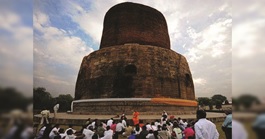08 December, 2025
Sarnath Nominated for UNESCO World Heritage Status
Thu 07 Aug, 2025
Reference:
- India has officially nominated the 'Ancient Buddhist Site, Sarnath' for inclusion in the UNESCO World Heritage List for the 2025–26 nomination cycle.
Key Points:
- Sarnath has been on UNESCO’s “Tentative List” since 1998.
Nomination Process and Timeline:
- Only One Nomination Allowed: As per the revised Operational Guidelines of UNESCO in 2024, each member country can send only one property for each nomination cycle.
- Timeline: The nomination process usually takes about 1.5 years, involving technical review, advisory body recommendations, and final approval by the World Heritage Committee.
Conservation and Preparations:
- Role of ASI: The Archaeological Survey of India (ASI) maintains all protected monuments and undertakes conservation work based on budget availability and necessity. This includes use of digital technology and museum planning.
- Museums and Awareness: ASI currently manages 52 site museums and is adopting digital tools to enhance visitor experience. Outreach programs are also being conducted to raise cultural awareness among youth.
Sarnath general information
| Aspect | Details |
| Location | Varanasi, Uttar Pradesh |
|
Historical Significance
Main Monuments |
Gautam Buddha gave his first sermon here in 528 BCE, known as "Dharmachakra Pravartan"
|
| Main Sites |
|
| Timeline | From 3rd century BCE to 12th century CE (Maurya, Shunga, Kushan, Gupta periods; Chaukhandi Stupa reconstructed in Mughal era) |
| Archaeological Significance | A center of Buddhist art, architecture, and urban planning; Ashokan pillar symbolizes Mauryan excellence and Buddhist patronage |
| Spiritual Significance | One of the four major Buddhist pilgrimage sites (along with Lumbini, Bodh Gaya, Kushinagar); sacred to Buddhist monks and pilgrims |
| Cultural Features | Witness to early Buddhist development; showcases Mauryan, Gupta, and Mughal architecture; also includes Jain and Hindu relics |
General Information – UNESCO
- Full Name: United Nations Educational, Scientific and Cultural Organization
- Established: 1945
- Headquarters: Paris, France
- Main Objective: To promote peace and sustainable development through education, science, culture, and communication
- The World Heritage Convention is an international agreement established by UNESCO in 1972
- As of October 2024, there are 1,223 World Heritage Sites across 196 countries (952 Cultural, 231 Natural, 40 Mixed)
- India has 43 World Heritage Sites, with Agra Fort, Taj Mahal, and Ajanta and Ellora Caves being the first to be listed in 1983
- The latest addition is Moidams of Assam (Ahom dynasty’s burial mounds), inscribed in July 2024
- World Heritage Day is celebrated on 18 April every year (Theme for 2025: "Heritage at Risk from Disasters and Conflicts: Preparedness and Lessons from 60 Years of ICOMOS Action")
Government Initiatives to Promote India’s Rich Cultural Heritage
Recovery of Antiquities:
- The Archaeological Survey of India is committed to conserving cultural property.
- From 1976 to 2024, 655 antiquities have been recovered from foreign countries, of which 642 have been recovered since 2014.
Adopt a Heritage Scheme:
- The Adopt a Heritage program was launched in 2017 and restructured as Adopt a Heritage 2.0 in 2023.
- It allows private and public groups to help develop facilities at protected monuments using their Corporate Social Responsibility (CSR) funds.
- Under this scheme, ASI and various state-level partners have signed 21 MoUs so far.
46th Session of the World Heritage Committee:
- The ASI and Ministry of Culture successfully hosted the 46th session of the World Heritage Committee in Delhi from 21–31 July 2024.
- The session was inaugurated by the Prime Minister, and was attended by nearly 2,900 international and national delegates from over 140 countries.
- Delegates discussed and collaborated on cultural, natural, and mixed heritage protection — a major step in India’s global heritage leadership.
Monuments of National Importance:
- India has 3,697 ancient monuments and archaeological sites declared as monuments of national importance.
Digitization of India’s Cultural Heritage:
- The National Mission on Monuments and Antiquities (NMMA), established in 2007, is responsible for digitizing and documenting India’s heritage and antiquities.
- Till now, over 1.23 million antiquities and 11,406 heritage sites have been documented.
- For 2024–25, the mission has been allocated ₹20 lakh.
Classical Language Status:
- On 3 October 2024, the government granted classical language status to Assamese, Marathi, Pali, Prakrit, and Bengali, raising the total to 11 classical Indian languages.
- This step reflects the commitment to preserve India’s diverse and ancient linguistic heritage.
India’s First Archaeological Experiential Museum:
- Union Minister Amit Shah inaugurated the Archaeological Experiential Museum in Vadnagar on 16 January 2025.
World Heritage Site Museum at Humayun’s Tomb:
- On 29 July 2024, a state-of-the-art museum spread over 100,000 sq. ft. was inaugurated at the UNESCO World Heritage Site of Humayun’s Tomb in Delhi.


















